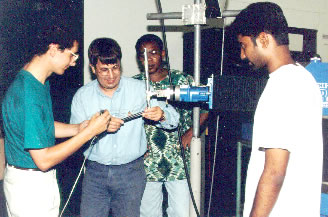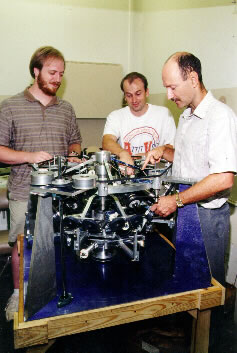Impact Dynamics Laboratory
 The IMPACT DYNAMICS Laboratory investigates industrially relevant problems associated with impact dynamics, friction, and lubrication. The principal component in the setup is a WATSMART three-dimensional digitizing and motion analysis system. This system comprises of a pair of infrared cameras linked to a data acquisition and digitizing unit, and is controlled through a computer. The cameras through a pre-calibrated space track active infrared emitting diodes attached to the target object. This system has a sampling rate of 4200 Hz.. A planar two-link chain system is being used for ongoing impact experimental studies. Recent research has emphasized the mechanisms of collision with solid lubrication.
The IMPACT DYNAMICS Laboratory investigates industrially relevant problems associated with impact dynamics, friction, and lubrication. The principal component in the setup is a WATSMART three-dimensional digitizing and motion analysis system. This system comprises of a pair of infrared cameras linked to a data acquisition and digitizing unit, and is controlled through a computer. The cameras through a pre-calibrated space track active infrared emitting diodes attached to the target object. This system has a sampling rate of 4200 Hz.. A planar two-link chain system is being used for ongoing impact experimental studies. Recent research has emphasized the mechanisms of collision with solid lubrication.
Other work in the laboratory includes research into dynamics and control of multibody systems. The laboratory is also equipped with a Seiko D-Tran industrial robot. We seek to develop intelligent robots and walking machines that are capable of navigating in unstructured terrain and adapting to changing environments.
The laboratory currently houses one SUN SPARCstation and three MacIntosh computers. The development of stability tools for the multidisciplinary design of ground vehicles is also underway. This would involve the use of artificial neural networks and incorporates distributed processing (i.e., parallel processing) for computer aided engineering processes. Other focus areas include biomechanics and design for manufacturing.
Machine Simulation and Analysis Laboratory
 This new laboratory is dedicated to the construction, dynamics and control of industrial mechanisms and machines. The lab has been used to study slider cranks and four bars mechanisms, although it is not limited to these applications. In a recently completed experiment a flexible rod slider crank mechanism was driven at high speeds with a ½ HP DC motor drive and VariAC AC-DC power converter. The mechanism was shrouded with a plexiglass and steel enclosure to protect the operator. Strain gage voltages were amplified using a Model 2120A Measurement Group strain gage conditioner. Voltage signals were fed to a 80386 PC with a high speed 4 channel data acquisition system, and flexible rod response, stresses, and strains were later extracted from the stored data. Software resident on the PC was used to immediately view strain gage response and FFT response. The mechanism was constructed in our well-equipped machine shop. Accelerometers have also been attached to sense vibrations transmitted by the operating mechanism to its base. Other projects performed in the lab have included determination of power requirements for a beach cleaning machine, studies of vibrating beams, and the design and construction of a innovative braiding machine. The braider is speed controlled, capable of very high speeds, with deflectors that are solenoid actuated. Deflectors are also computer controllable, permitting a multitude of braid patterns as yet unavailable. The braider project has been a prime example that demonstrates a marriage of mechanical engineering (machine design) and textile engineering (i.e. braiding) to achieve a unique and innovative product. The braider is currently being patented. Not to be overlooked are the powerful computational capabilities (both hardware and software) available on the SUN network. Mechanical systems simulation and control packages - such as ADAMS, MATLAB, and others - that are readily available, along with a suite of numerical and finite element codes to correlate experimental and analytical results.
This new laboratory is dedicated to the construction, dynamics and control of industrial mechanisms and machines. The lab has been used to study slider cranks and four bars mechanisms, although it is not limited to these applications. In a recently completed experiment a flexible rod slider crank mechanism was driven at high speeds with a ½ HP DC motor drive and VariAC AC-DC power converter. The mechanism was shrouded with a plexiglass and steel enclosure to protect the operator. Strain gage voltages were amplified using a Model 2120A Measurement Group strain gage conditioner. Voltage signals were fed to a 80386 PC with a high speed 4 channel data acquisition system, and flexible rod response, stresses, and strains were later extracted from the stored data. Software resident on the PC was used to immediately view strain gage response and FFT response. The mechanism was constructed in our well-equipped machine shop. Accelerometers have also been attached to sense vibrations transmitted by the operating mechanism to its base. Other projects performed in the lab have included determination of power requirements for a beach cleaning machine, studies of vibrating beams, and the design and construction of a innovative braiding machine. The braider is speed controlled, capable of very high speeds, with deflectors that are solenoid actuated. Deflectors are also computer controllable, permitting a multitude of braid patterns as yet unavailable. The braider project has been a prime example that demonstrates a marriage of mechanical engineering (machine design) and textile engineering (i.e. braiding) to achieve a unique and innovative product. The braider is currently being patented. Not to be overlooked are the powerful computational capabilities (both hardware and software) available on the SUN network. Mechanical systems simulation and control packages - such as ADAMS, MATLAB, and others - that are readily available, along with a suite of numerical and finite element codes to correlate experimental and analytical results.

